Financial Accounting Report: Principles, Analysis, and Client Data
VerifiedAdded on 2020/11/23
|25
|4718
|70
Report
AI Summary
This report provides a comprehensive overview of financial accounting, encompassing its purpose, regulations, accounting rules, and fundamental concepts and conventions. It delves into the core aspects of financial accounting, including the process of recording, classifying, and summarizing financial data to ascertain a business's financial position. The report explores the regulations governing financial accounting, including professional regulations and international standards like IFRS. It details accounting rules such as the double-entry system and the golden rules, along with accounting principles such as economic entity, time period, monetary unit, cost, full disclosure, going concern, matching, revenue recognition, materiality, and conservatism. The report also provides practical application through the analysis of client data, including ledger accounts, and other financial statements. The report concludes with a reference section for further study.
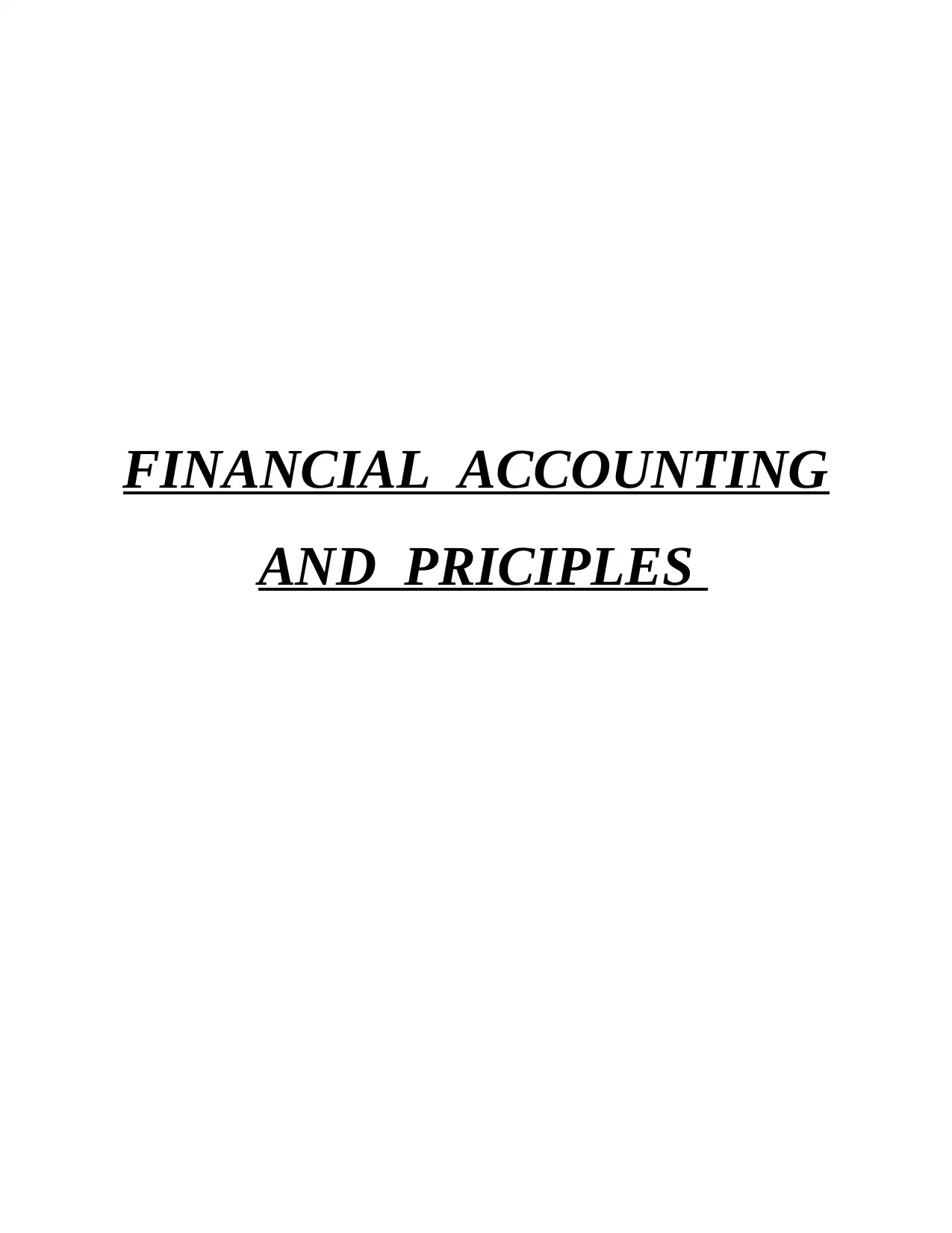
FINANCIAL ACCOUNTING
AND PRICIPLES
AND PRICIPLES
Paraphrase This Document
Need a fresh take? Get an instant paraphrase of this document with our AI Paraphraser
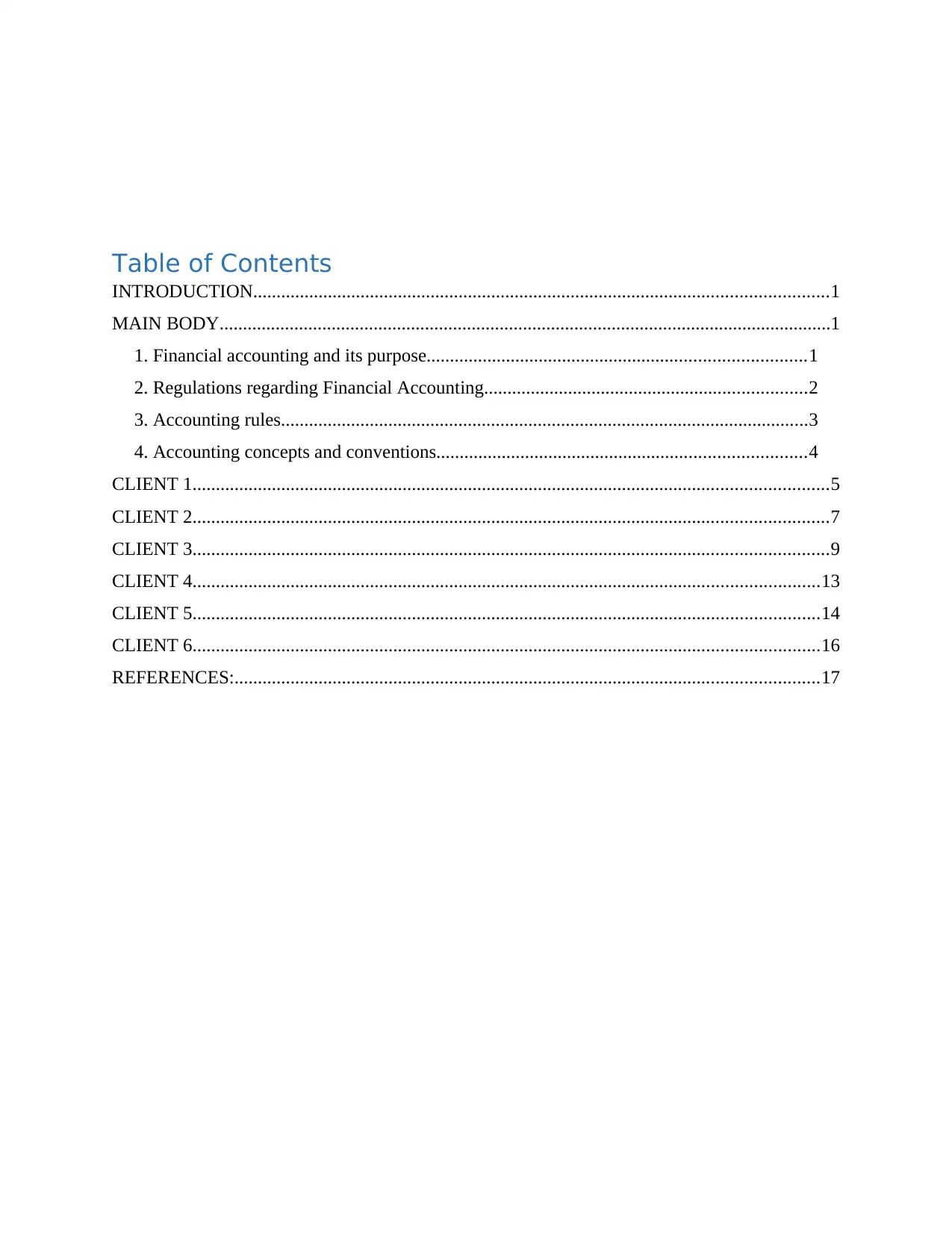
Table of Contents
INTRODUCTION...........................................................................................................................1
MAIN BODY...................................................................................................................................1
1. Financial accounting and its purpose.................................................................................1
2. Regulations regarding Financial Accounting.....................................................................2
3. Accounting rules.................................................................................................................3
4. Accounting concepts and conventions...............................................................................4
CLIENT 1........................................................................................................................................5
CLIENT 2........................................................................................................................................7
CLIENT 3........................................................................................................................................9
CLIENT 4......................................................................................................................................13
CLIENT 5......................................................................................................................................14
CLIENT 6......................................................................................................................................16
REFERENCES:.............................................................................................................................17
INTRODUCTION...........................................................................................................................1
MAIN BODY...................................................................................................................................1
1. Financial accounting and its purpose.................................................................................1
2. Regulations regarding Financial Accounting.....................................................................2
3. Accounting rules.................................................................................................................3
4. Accounting concepts and conventions...............................................................................4
CLIENT 1........................................................................................................................................5
CLIENT 2........................................................................................................................................7
CLIENT 3........................................................................................................................................9
CLIENT 4......................................................................................................................................13
CLIENT 5......................................................................................................................................14
CLIENT 6......................................................................................................................................16
REFERENCES:.............................................................................................................................17
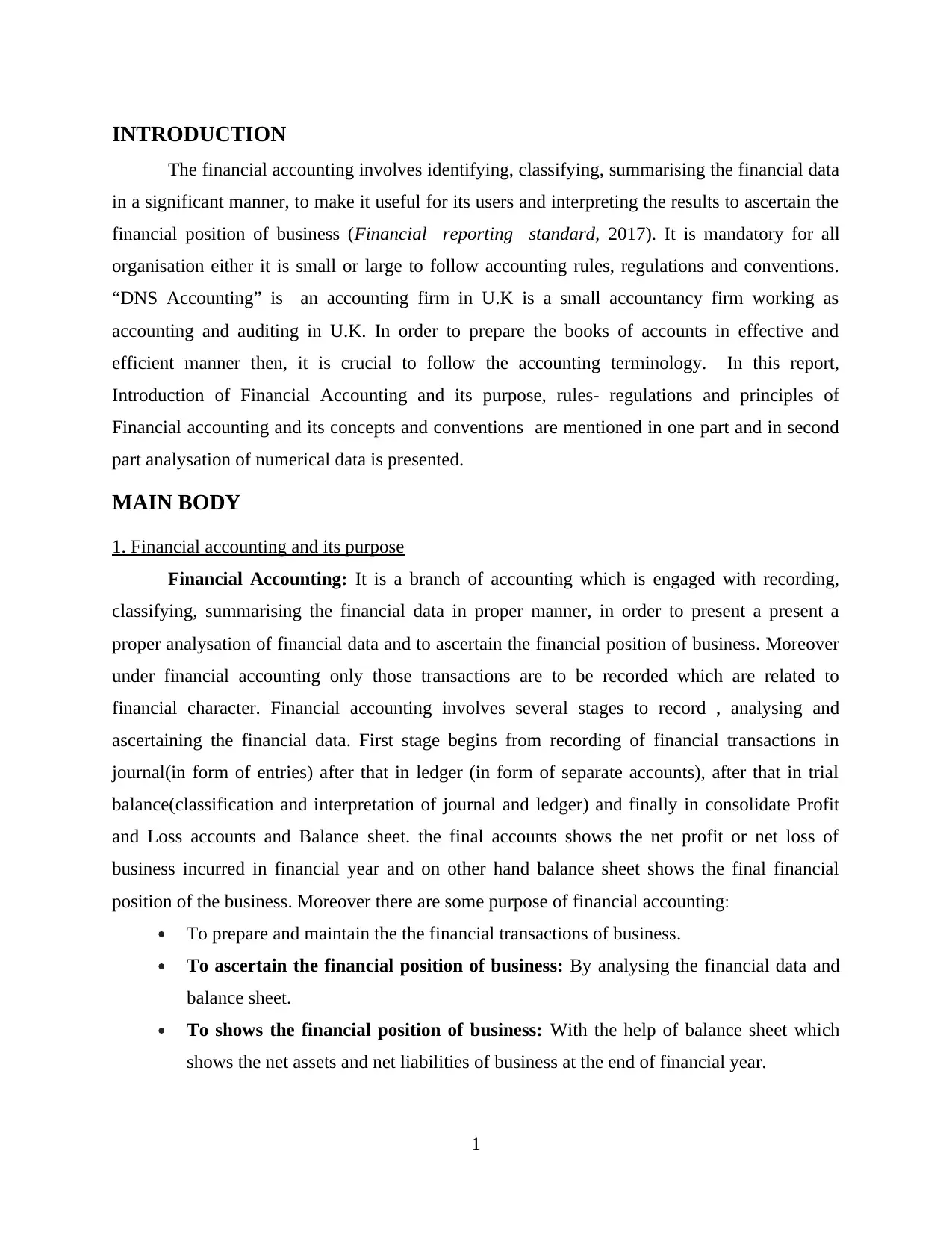
INTRODUCTION
The financial accounting involves identifying, classifying, summarising the financial data
in a significant manner, to make it useful for its users and interpreting the results to ascertain the
financial position of business (Financial reporting standard, 2017). It is mandatory for all
organisation either it is small or large to follow accounting rules, regulations and conventions.
“DNS Accounting” is an accounting firm in U.K is a small accountancy firm working as
accounting and auditing in U.K. In order to prepare the books of accounts in effective and
efficient manner then, it is crucial to follow the accounting terminology. In this report,
Introduction of Financial Accounting and its purpose, rules- regulations and principles of
Financial accounting and its concepts and conventions are mentioned in one part and in second
part analysation of numerical data is presented.
MAIN BODY
1. Financial accounting and its purpose
Financial Accounting: It is a branch of accounting which is engaged with recording,
classifying, summarising the financial data in proper manner, in order to present a present a
proper analysation of financial data and to ascertain the financial position of business. Moreover
under financial accounting only those transactions are to be recorded which are related to
financial character. Financial accounting involves several stages to record , analysing and
ascertaining the financial data. First stage begins from recording of financial transactions in
journal(in form of entries) after that in ledger (in form of separate accounts), after that in trial
balance(classification and interpretation of journal and ledger) and finally in consolidate Profit
and Loss accounts and Balance sheet. the final accounts shows the net profit or net loss of
business incurred in financial year and on other hand balance sheet shows the final financial
position of the business. Moreover there are some purpose of financial accounting:
To prepare and maintain the the financial transactions of business.
To ascertain the financial position of business: By analysing the financial data and
balance sheet.
To shows the financial position of business: With the help of balance sheet which
shows the net assets and net liabilities of business at the end of financial year.
1
The financial accounting involves identifying, classifying, summarising the financial data
in a significant manner, to make it useful for its users and interpreting the results to ascertain the
financial position of business (Financial reporting standard, 2017). It is mandatory for all
organisation either it is small or large to follow accounting rules, regulations and conventions.
“DNS Accounting” is an accounting firm in U.K is a small accountancy firm working as
accounting and auditing in U.K. In order to prepare the books of accounts in effective and
efficient manner then, it is crucial to follow the accounting terminology. In this report,
Introduction of Financial Accounting and its purpose, rules- regulations and principles of
Financial accounting and its concepts and conventions are mentioned in one part and in second
part analysation of numerical data is presented.
MAIN BODY
1. Financial accounting and its purpose
Financial Accounting: It is a branch of accounting which is engaged with recording,
classifying, summarising the financial data in proper manner, in order to present a present a
proper analysation of financial data and to ascertain the financial position of business. Moreover
under financial accounting only those transactions are to be recorded which are related to
financial character. Financial accounting involves several stages to record , analysing and
ascertaining the financial data. First stage begins from recording of financial transactions in
journal(in form of entries) after that in ledger (in form of separate accounts), after that in trial
balance(classification and interpretation of journal and ledger) and finally in consolidate Profit
and Loss accounts and Balance sheet. the final accounts shows the net profit or net loss of
business incurred in financial year and on other hand balance sheet shows the final financial
position of the business. Moreover there are some purpose of financial accounting:
To prepare and maintain the the financial transactions of business.
To ascertain the financial position of business: By analysing the financial data and
balance sheet.
To shows the financial position of business: With the help of balance sheet which
shows the net assets and net liabilities of business at the end of financial year.
1
⊘ This is a preview!⊘
Do you want full access?
Subscribe today to unlock all pages.

Trusted by 1+ million students worldwide
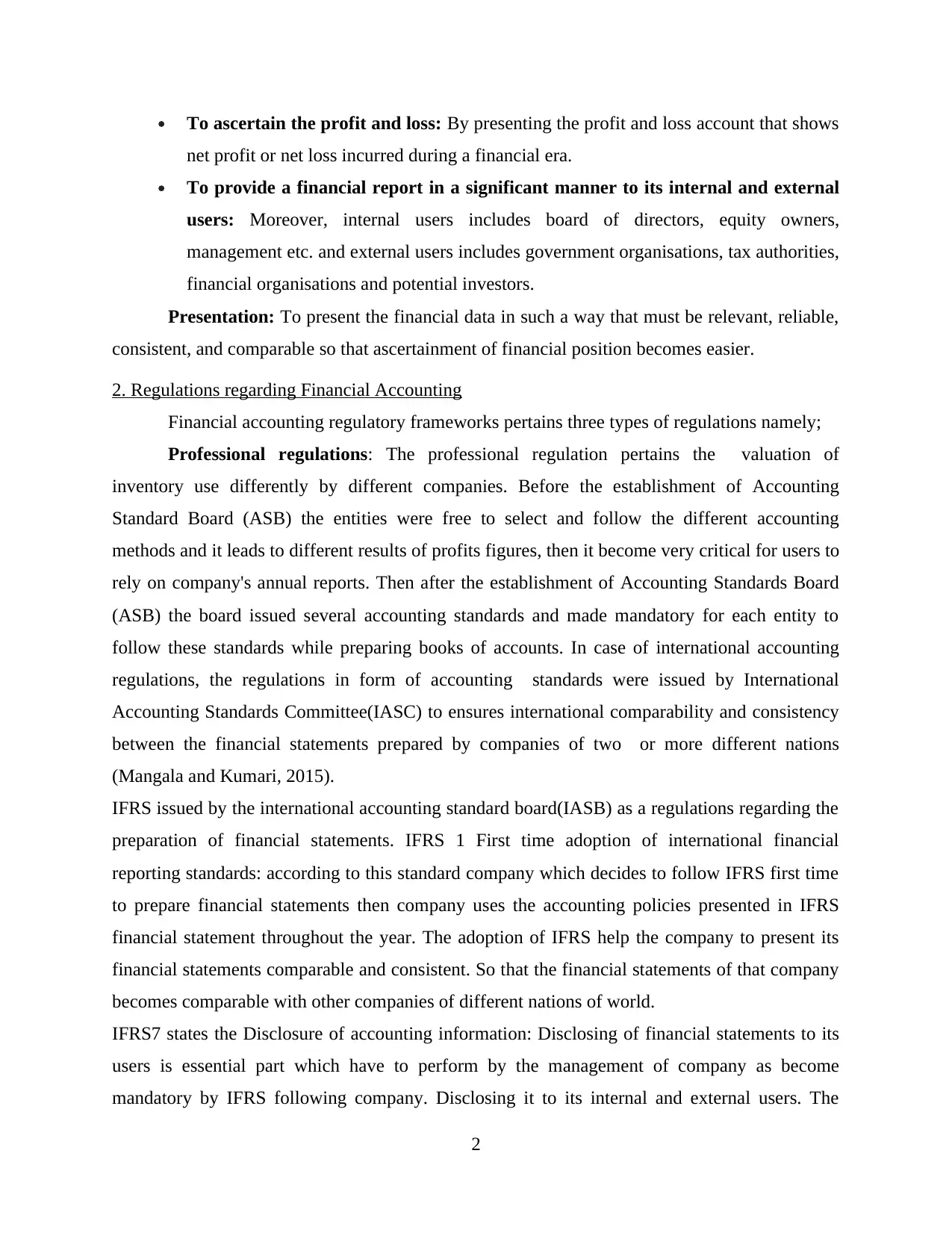
To ascertain the profit and loss: By presenting the profit and loss account that shows
net profit or net loss incurred during a financial era.
To provide a financial report in a significant manner to its internal and external
users: Moreover, internal users includes board of directors, equity owners,
management etc. and external users includes government organisations, tax authorities,
financial organisations and potential investors.
Presentation: To present the financial data in such a way that must be relevant, reliable,
consistent, and comparable so that ascertainment of financial position becomes easier.
2. Regulations regarding Financial Accounting
Financial accounting regulatory frameworks pertains three types of regulations namely;
Professional regulations: The professional regulation pertains the valuation of
inventory use differently by different companies. Before the establishment of Accounting
Standard Board (ASB) the entities were free to select and follow the different accounting
methods and it leads to different results of profits figures, then it become very critical for users to
rely on company's annual reports. Then after the establishment of Accounting Standards Board
(ASB) the board issued several accounting standards and made mandatory for each entity to
follow these standards while preparing books of accounts. In case of international accounting
regulations, the regulations in form of accounting standards were issued by International
Accounting Standards Committee(IASC) to ensures international comparability and consistency
between the financial statements prepared by companies of two or more different nations
(Mangala and Kumari, 2015).
IFRS issued by the international accounting standard board(IASB) as a regulations regarding the
preparation of financial statements. IFRS 1 First time adoption of international financial
reporting standards: according to this standard company which decides to follow IFRS first time
to prepare financial statements then company uses the accounting policies presented in IFRS
financial statement throughout the year. The adoption of IFRS help the company to present its
financial statements comparable and consistent. So that the financial statements of that company
becomes comparable with other companies of different nations of world.
IFRS7 states the Disclosure of accounting information: Disclosing of financial statements to its
users is essential part which have to perform by the management of company as become
mandatory by IFRS following company. Disclosing it to its internal and external users. The
2
net profit or net loss incurred during a financial era.
To provide a financial report in a significant manner to its internal and external
users: Moreover, internal users includes board of directors, equity owners,
management etc. and external users includes government organisations, tax authorities,
financial organisations and potential investors.
Presentation: To present the financial data in such a way that must be relevant, reliable,
consistent, and comparable so that ascertainment of financial position becomes easier.
2. Regulations regarding Financial Accounting
Financial accounting regulatory frameworks pertains three types of regulations namely;
Professional regulations: The professional regulation pertains the valuation of
inventory use differently by different companies. Before the establishment of Accounting
Standard Board (ASB) the entities were free to select and follow the different accounting
methods and it leads to different results of profits figures, then it become very critical for users to
rely on company's annual reports. Then after the establishment of Accounting Standards Board
(ASB) the board issued several accounting standards and made mandatory for each entity to
follow these standards while preparing books of accounts. In case of international accounting
regulations, the regulations in form of accounting standards were issued by International
Accounting Standards Committee(IASC) to ensures international comparability and consistency
between the financial statements prepared by companies of two or more different nations
(Mangala and Kumari, 2015).
IFRS issued by the international accounting standard board(IASB) as a regulations regarding the
preparation of financial statements. IFRS 1 First time adoption of international financial
reporting standards: according to this standard company which decides to follow IFRS first time
to prepare financial statements then company uses the accounting policies presented in IFRS
financial statement throughout the year. The adoption of IFRS help the company to present its
financial statements comparable and consistent. So that the financial statements of that company
becomes comparable with other companies of different nations of world.
IFRS7 states the Disclosure of accounting information: Disclosing of financial statements to its
users is essential part which have to perform by the management of company as become
mandatory by IFRS following company. Disclosing it to its internal and external users. The
2
Paraphrase This Document
Need a fresh take? Get an instant paraphrase of this document with our AI Paraphraser
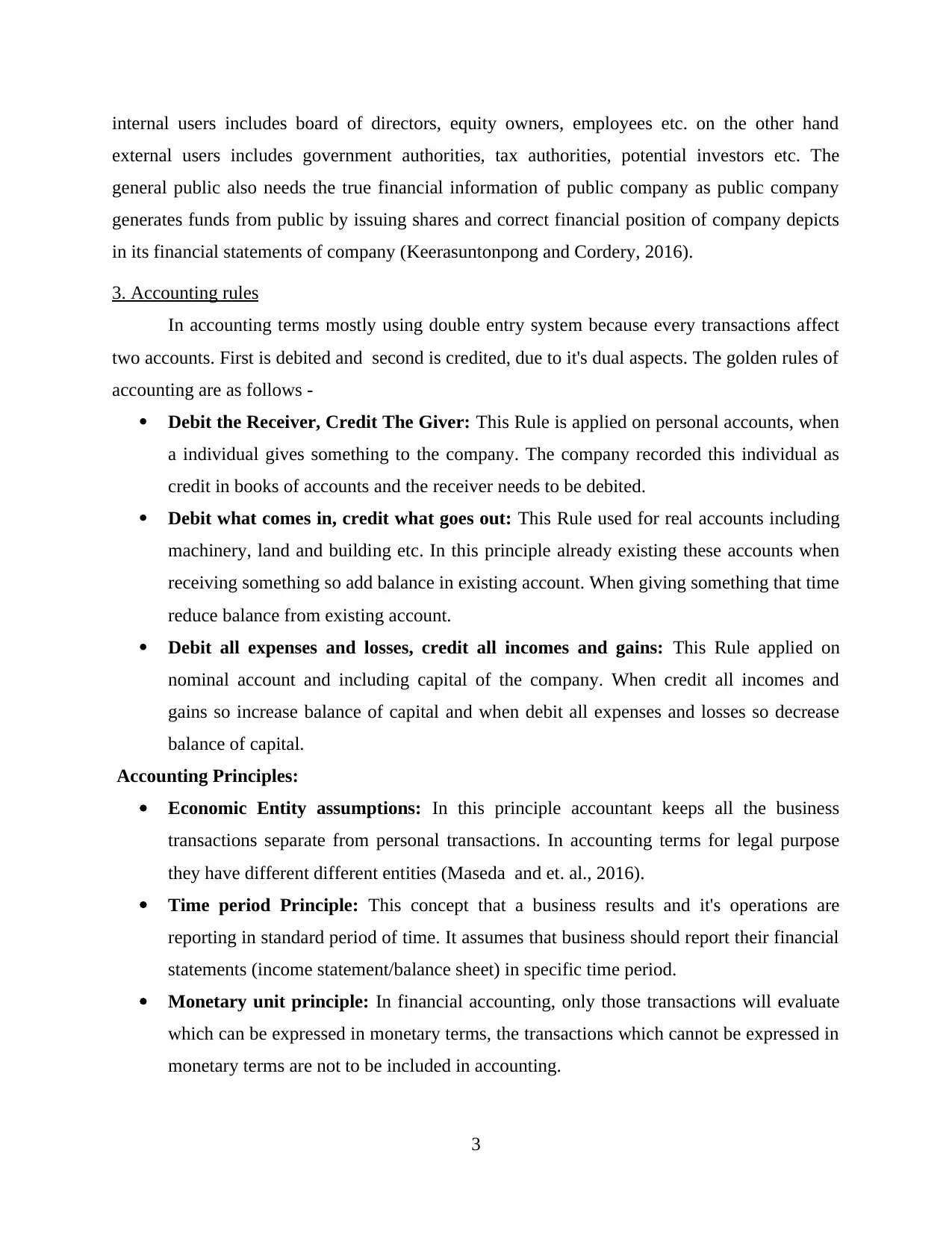
internal users includes board of directors, equity owners, employees etc. on the other hand
external users includes government authorities, tax authorities, potential investors etc. The
general public also needs the true financial information of public company as public company
generates funds from public by issuing shares and correct financial position of company depicts
in its financial statements of company (Keerasuntonpong and Cordery, 2016).
3. Accounting rules
In accounting terms mostly using double entry system because every transactions affect
two accounts. First is debited and second is credited, due to it's dual aspects. The golden rules of
accounting are as follows -
Debit the Receiver, Credit The Giver: This Rule is applied on personal accounts, when
a individual gives something to the company. The company recorded this individual as
credit in books of accounts and the receiver needs to be debited.
Debit what comes in, credit what goes out: This Rule used for real accounts including
machinery, land and building etc. In this principle already existing these accounts when
receiving something so add balance in existing account. When giving something that time
reduce balance from existing account.
Debit all expenses and losses, credit all incomes and gains: This Rule applied on
nominal account and including capital of the company. When credit all incomes and
gains so increase balance of capital and when debit all expenses and losses so decrease
balance of capital.
Accounting Principles:
Economic Entity assumptions: In this principle accountant keeps all the business
transactions separate from personal transactions. In accounting terms for legal purpose
they have different different entities (Maseda and et. al., 2016).
Time period Principle: This concept that a business results and it's operations are
reporting in standard period of time. It assumes that business should report their financial
statements (income statement/balance sheet) in specific time period.
Monetary unit principle: In financial accounting, only those transactions will evaluate
which can be expressed in monetary terms, the transactions which cannot be expressed in
monetary terms are not to be included in accounting.
3
external users includes government authorities, tax authorities, potential investors etc. The
general public also needs the true financial information of public company as public company
generates funds from public by issuing shares and correct financial position of company depicts
in its financial statements of company (Keerasuntonpong and Cordery, 2016).
3. Accounting rules
In accounting terms mostly using double entry system because every transactions affect
two accounts. First is debited and second is credited, due to it's dual aspects. The golden rules of
accounting are as follows -
Debit the Receiver, Credit The Giver: This Rule is applied on personal accounts, when
a individual gives something to the company. The company recorded this individual as
credit in books of accounts and the receiver needs to be debited.
Debit what comes in, credit what goes out: This Rule used for real accounts including
machinery, land and building etc. In this principle already existing these accounts when
receiving something so add balance in existing account. When giving something that time
reduce balance from existing account.
Debit all expenses and losses, credit all incomes and gains: This Rule applied on
nominal account and including capital of the company. When credit all incomes and
gains so increase balance of capital and when debit all expenses and losses so decrease
balance of capital.
Accounting Principles:
Economic Entity assumptions: In this principle accountant keeps all the business
transactions separate from personal transactions. In accounting terms for legal purpose
they have different different entities (Maseda and et. al., 2016).
Time period Principle: This concept that a business results and it's operations are
reporting in standard period of time. It assumes that business should report their financial
statements (income statement/balance sheet) in specific time period.
Monetary unit principle: In financial accounting, only those transactions will evaluate
which can be expressed in monetary terms, the transactions which cannot be expressed in
monetary terms are not to be included in accounting.
3
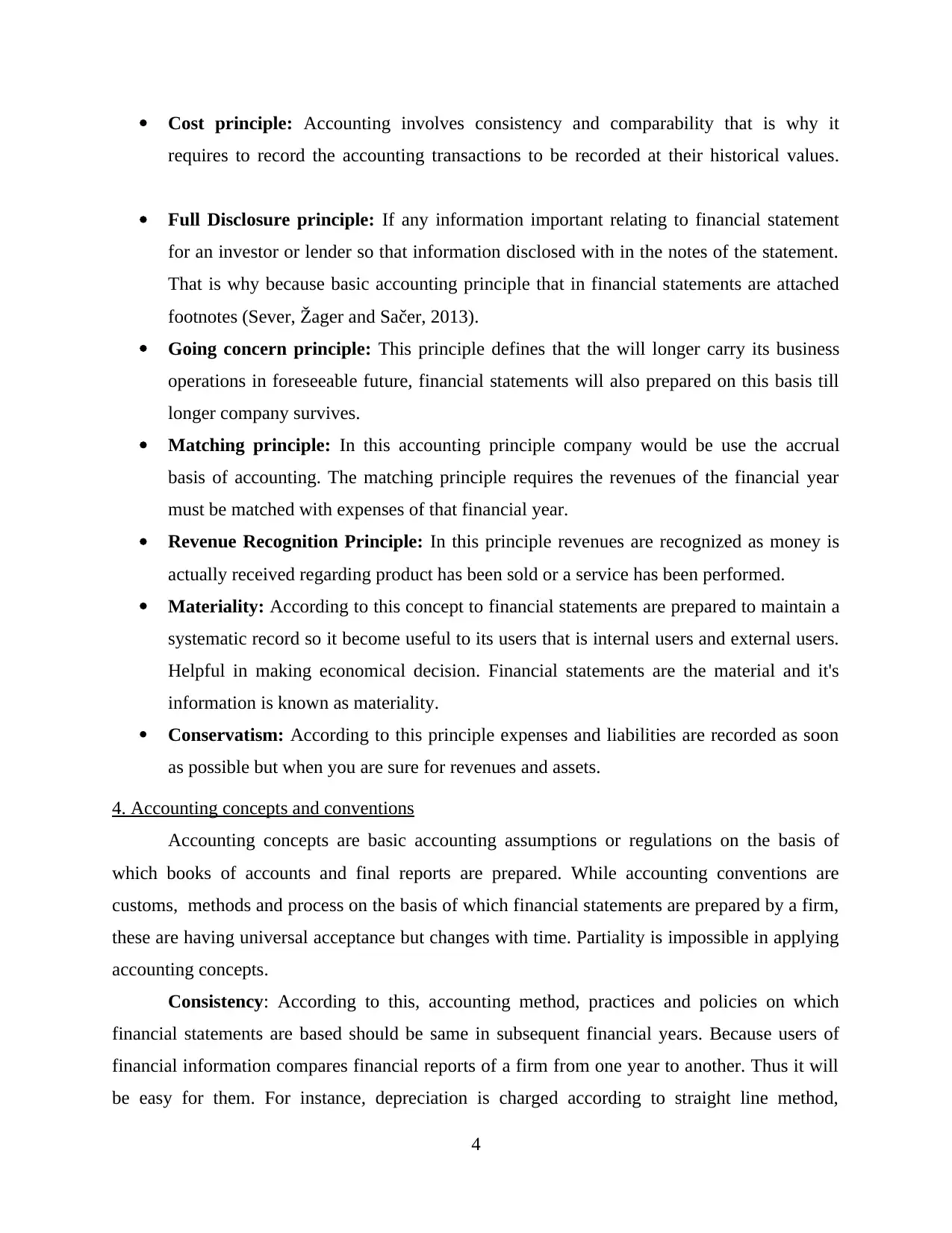
Cost principle: Accounting involves consistency and comparability that is why it
requires to record the accounting transactions to be recorded at their historical values.
Full Disclosure principle: If any information important relating to financial statement
for an investor or lender so that information disclosed with in the notes of the statement.
That is why because basic accounting principle that in financial statements are attached
footnotes (Sever, Žager and Sačer, 2013).
Going concern principle: This principle defines that the will longer carry its business
operations in foreseeable future, financial statements will also prepared on this basis till
longer company survives.
Matching principle: In this accounting principle company would be use the accrual
basis of accounting. The matching principle requires the revenues of the financial year
must be matched with expenses of that financial year.
Revenue Recognition Principle: In this principle revenues are recognized as money is
actually received regarding product has been sold or a service has been performed.
Materiality: According to this concept to financial statements are prepared to maintain a
systematic record so it become useful to its users that is internal users and external users.
Helpful in making economical decision. Financial statements are the material and it's
information is known as materiality.
Conservatism: According to this principle expenses and liabilities are recorded as soon
as possible but when you are sure for revenues and assets.
4. Accounting concepts and conventions
Accounting concepts are basic accounting assumptions or regulations on the basis of
which books of accounts and final reports are prepared. While accounting conventions are
customs, methods and process on the basis of which financial statements are prepared by a firm,
these are having universal acceptance but changes with time. Partiality is impossible in applying
accounting concepts.
Consistency: According to this, accounting method, practices and policies on which
financial statements are based should be same in subsequent financial years. Because users of
financial information compares financial reports of a firm from one year to another. Thus it will
be easy for them. For instance, depreciation is charged according to straight line method,
4
requires to record the accounting transactions to be recorded at their historical values.
Full Disclosure principle: If any information important relating to financial statement
for an investor or lender so that information disclosed with in the notes of the statement.
That is why because basic accounting principle that in financial statements are attached
footnotes (Sever, Žager and Sačer, 2013).
Going concern principle: This principle defines that the will longer carry its business
operations in foreseeable future, financial statements will also prepared on this basis till
longer company survives.
Matching principle: In this accounting principle company would be use the accrual
basis of accounting. The matching principle requires the revenues of the financial year
must be matched with expenses of that financial year.
Revenue Recognition Principle: In this principle revenues are recognized as money is
actually received regarding product has been sold or a service has been performed.
Materiality: According to this concept to financial statements are prepared to maintain a
systematic record so it become useful to its users that is internal users and external users.
Helpful in making economical decision. Financial statements are the material and it's
information is known as materiality.
Conservatism: According to this principle expenses and liabilities are recorded as soon
as possible but when you are sure for revenues and assets.
4. Accounting concepts and conventions
Accounting concepts are basic accounting assumptions or regulations on the basis of
which books of accounts and final reports are prepared. While accounting conventions are
customs, methods and process on the basis of which financial statements are prepared by a firm,
these are having universal acceptance but changes with time. Partiality is impossible in applying
accounting concepts.
Consistency: According to this, accounting method, practices and policies on which
financial statements are based should be same in subsequent financial years. Because users of
financial information compares financial reports of a firm from one year to another. Thus it will
be easy for them. For instance, depreciation is charged according to straight line method,
4
⊘ This is a preview!⊘
Do you want full access?
Subscribe today to unlock all pages.

Trusted by 1+ million students worldwide
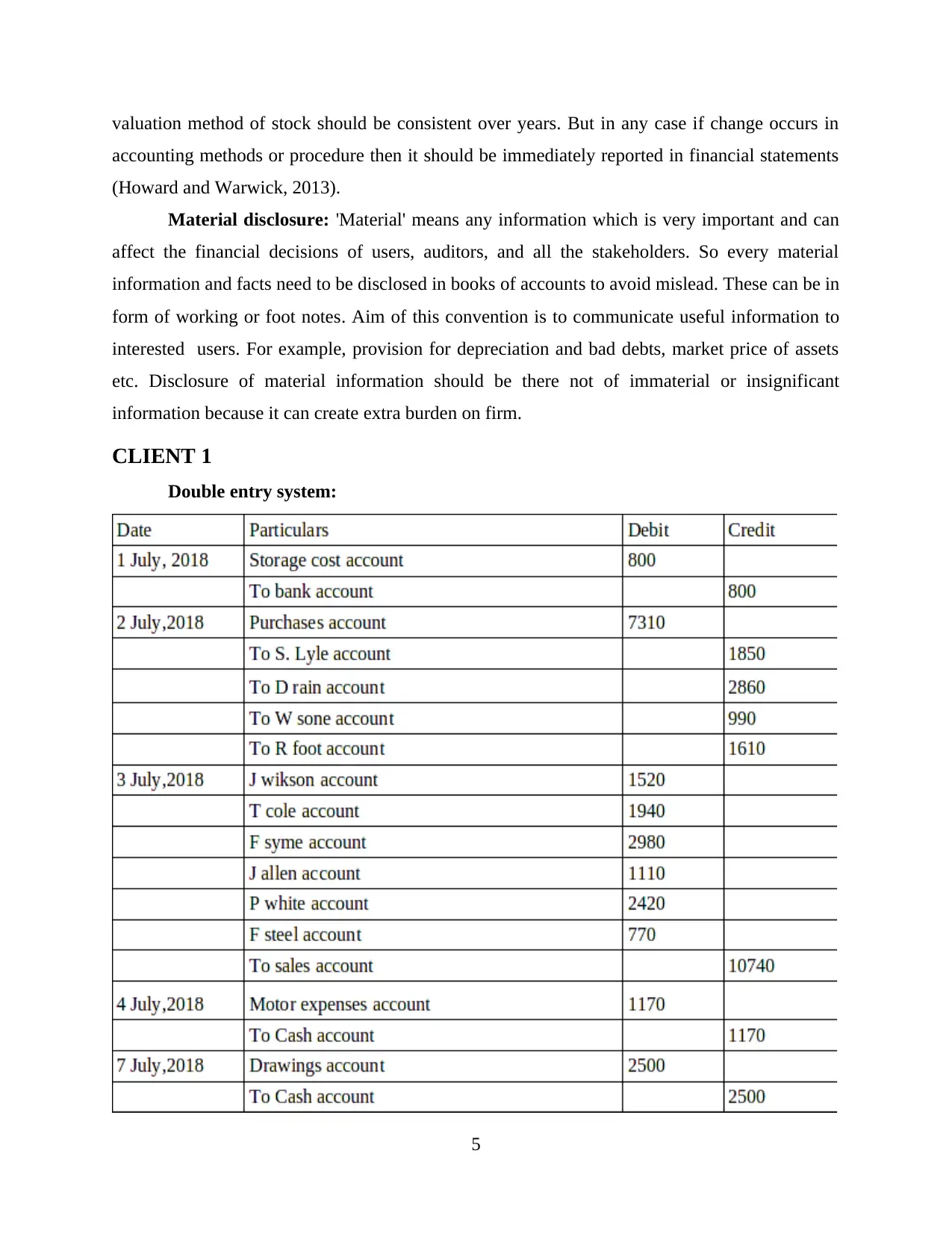
valuation method of stock should be consistent over years. But in any case if change occurs in
accounting methods or procedure then it should be immediately reported in financial statements
(Howard and Warwick, 2013).
Material disclosure: 'Material' means any information which is very important and can
affect the financial decisions of users, auditors, and all the stakeholders. So every material
information and facts need to be disclosed in books of accounts to avoid mislead. These can be in
form of working or foot notes. Aim of this convention is to communicate useful information to
interested users. For example, provision for depreciation and bad debts, market price of assets
etc. Disclosure of material information should be there not of immaterial or insignificant
information because it can create extra burden on firm.
CLIENT 1
Double entry system:
5
accounting methods or procedure then it should be immediately reported in financial statements
(Howard and Warwick, 2013).
Material disclosure: 'Material' means any information which is very important and can
affect the financial decisions of users, auditors, and all the stakeholders. So every material
information and facts need to be disclosed in books of accounts to avoid mislead. These can be in
form of working or foot notes. Aim of this convention is to communicate useful information to
interested users. For example, provision for depreciation and bad debts, market price of assets
etc. Disclosure of material information should be there not of immaterial or insignificant
information because it can create extra burden on firm.
CLIENT 1
Double entry system:
5
Paraphrase This Document
Need a fresh take? Get an instant paraphrase of this document with our AI Paraphraser
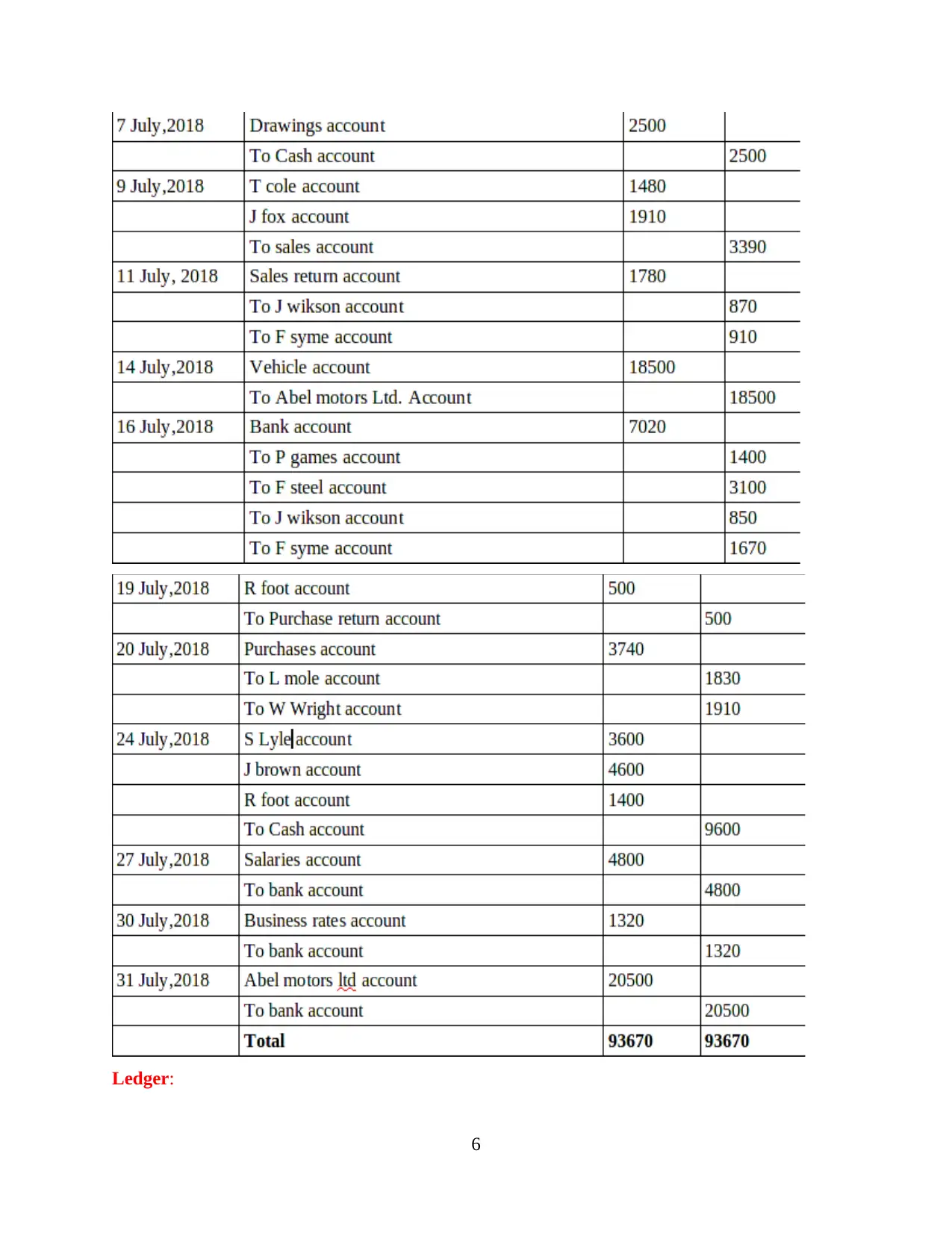
Ledger:
6
6
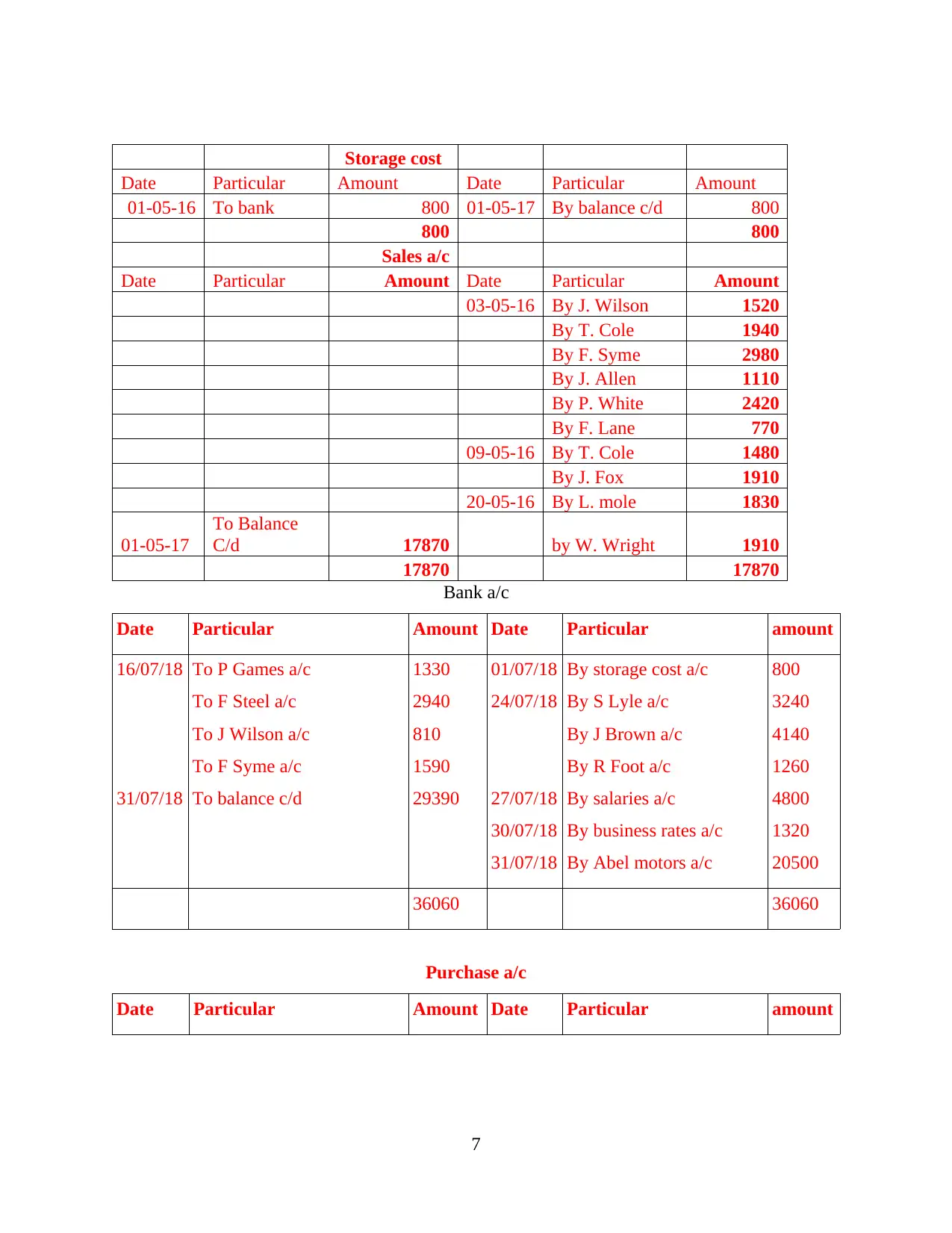
Storage cost
Date Particular Amount Date Particular Amount
01-05-16 To bank 800 01-05-17 By balance c/d 800
800 800
Sales a/c
Date Particular Amount Date Particular Amount
03-05-16 By J. Wilson 1520
By T. Cole 1940
By F. Syme 2980
By J. Allen 1110
By P. White 2420
By F. Lane 770
09-05-16 By T. Cole 1480
By J. Fox 1910
20-05-16 By L. mole 1830
01-05-17
To Balance
C/d 17870 by W. Wright 1910
17870 17870
Bank a/c
Date Particular Amount Date Particular amount
16/07/18
31/07/18
To P Games a/c
To F Steel a/c
To J Wilson a/c
To F Syme a/c
To balance c/d
1330
2940
810
1590
29390
01/07/18
24/07/18
27/07/18
30/07/18
31/07/18
By storage cost a/c
By S Lyle a/c
By J Brown a/c
By R Foot a/c
By salaries a/c
By business rates a/c
By Abel motors a/c
800
3240
4140
1260
4800
1320
20500
36060 36060
Purchase a/c
Date Particular Amount Date Particular amount
7
Date Particular Amount Date Particular Amount
01-05-16 To bank 800 01-05-17 By balance c/d 800
800 800
Sales a/c
Date Particular Amount Date Particular Amount
03-05-16 By J. Wilson 1520
By T. Cole 1940
By F. Syme 2980
By J. Allen 1110
By P. White 2420
By F. Lane 770
09-05-16 By T. Cole 1480
By J. Fox 1910
20-05-16 By L. mole 1830
01-05-17
To Balance
C/d 17870 by W. Wright 1910
17870 17870
Bank a/c
Date Particular Amount Date Particular amount
16/07/18
31/07/18
To P Games a/c
To F Steel a/c
To J Wilson a/c
To F Syme a/c
To balance c/d
1330
2940
810
1590
29390
01/07/18
24/07/18
27/07/18
30/07/18
31/07/18
By storage cost a/c
By S Lyle a/c
By J Brown a/c
By R Foot a/c
By salaries a/c
By business rates a/c
By Abel motors a/c
800
3240
4140
1260
4800
1320
20500
36060 36060
Purchase a/c
Date Particular Amount Date Particular amount
7
⊘ This is a preview!⊘
Do you want full access?
Subscribe today to unlock all pages.

Trusted by 1+ million students worldwide
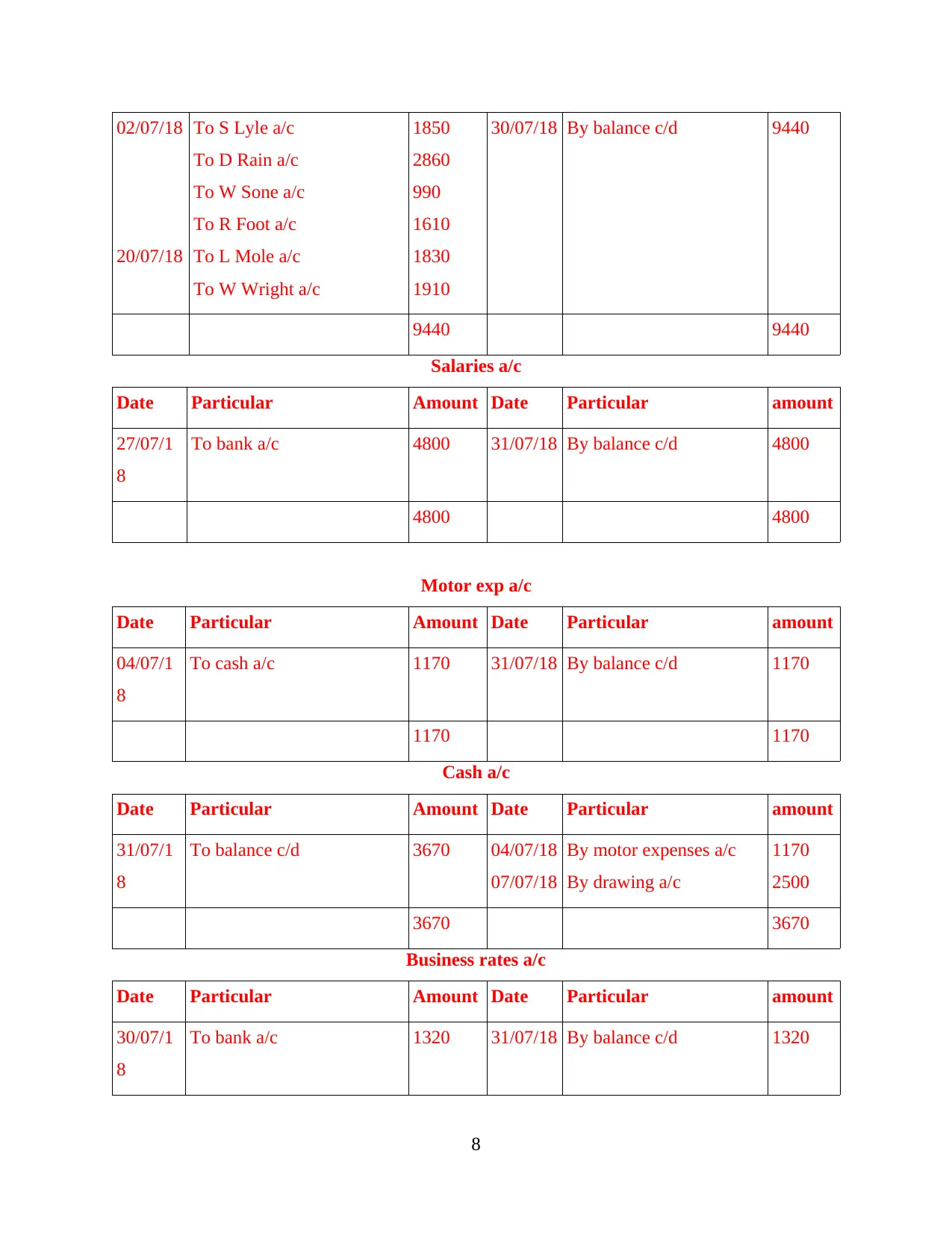
02/07/18
20/07/18
To S Lyle a/c
To D Rain a/c
To W Sone a/c
To R Foot a/c
To L Mole a/c
To W Wright a/c
1850
2860
990
1610
1830
1910
30/07/18 By balance c/d 9440
9440 9440
Salaries a/c
Date Particular Amount Date Particular amount
27/07/1
8
To bank a/c 4800 31/07/18 By balance c/d 4800
4800 4800
Motor exp a/c
Date Particular Amount Date Particular amount
04/07/1
8
To cash a/c 1170 31/07/18 By balance c/d 1170
1170 1170
Cash a/c
Date Particular Amount Date Particular amount
31/07/1
8
To balance c/d 3670 04/07/18
07/07/18
By motor expenses a/c
By drawing a/c
1170
2500
3670 3670
Business rates a/c
Date Particular Amount Date Particular amount
30/07/1
8
To bank a/c 1320 31/07/18 By balance c/d 1320
8
20/07/18
To S Lyle a/c
To D Rain a/c
To W Sone a/c
To R Foot a/c
To L Mole a/c
To W Wright a/c
1850
2860
990
1610
1830
1910
30/07/18 By balance c/d 9440
9440 9440
Salaries a/c
Date Particular Amount Date Particular amount
27/07/1
8
To bank a/c 4800 31/07/18 By balance c/d 4800
4800 4800
Motor exp a/c
Date Particular Amount Date Particular amount
04/07/1
8
To cash a/c 1170 31/07/18 By balance c/d 1170
1170 1170
Cash a/c
Date Particular Amount Date Particular amount
31/07/1
8
To balance c/d 3670 04/07/18
07/07/18
By motor expenses a/c
By drawing a/c
1170
2500
3670 3670
Business rates a/c
Date Particular Amount Date Particular amount
30/07/1
8
To bank a/c 1320 31/07/18 By balance c/d 1320
8
Paraphrase This Document
Need a fresh take? Get an instant paraphrase of this document with our AI Paraphraser
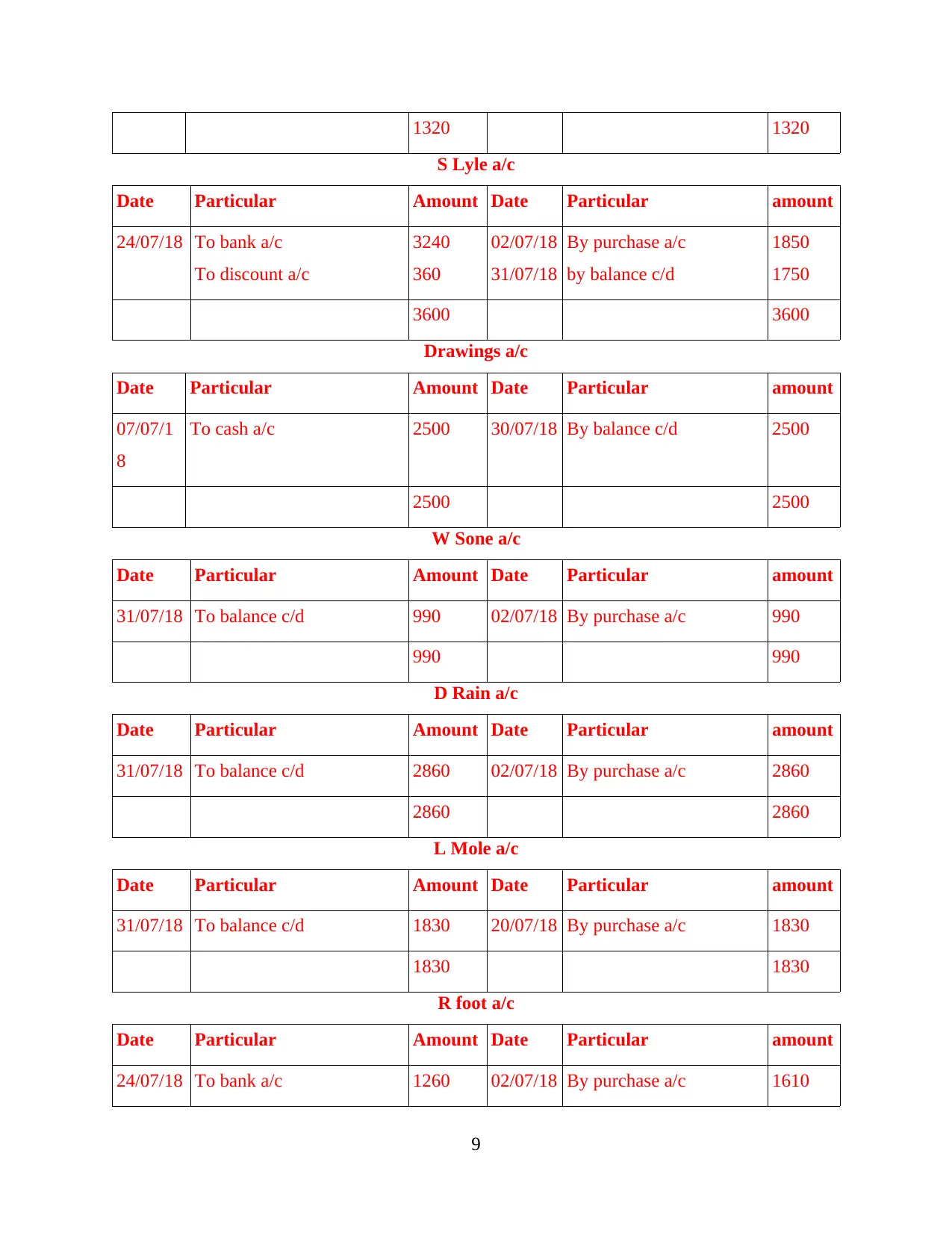
1320 1320
S Lyle a/c
Date Particular Amount Date Particular amount
24/07/18 To bank a/c
To discount a/c
3240
360
02/07/18
31/07/18
By purchase a/c
by balance c/d
1850
1750
3600 3600
Drawings a/c
Date Particular Amount Date Particular amount
07/07/1
8
To cash a/c 2500 30/07/18 By balance c/d 2500
2500 2500
W Sone a/c
Date Particular Amount Date Particular amount
31/07/18 To balance c/d 990 02/07/18 By purchase a/c 990
990 990
D Rain a/c
Date Particular Amount Date Particular amount
31/07/18 To balance c/d 2860 02/07/18 By purchase a/c 2860
2860 2860
L Mole a/c
Date Particular Amount Date Particular amount
31/07/18 To balance c/d 1830 20/07/18 By purchase a/c 1830
1830 1830
R foot a/c
Date Particular Amount Date Particular amount
24/07/18 To bank a/c 1260 02/07/18 By purchase a/c 1610
9
S Lyle a/c
Date Particular Amount Date Particular amount
24/07/18 To bank a/c
To discount a/c
3240
360
02/07/18
31/07/18
By purchase a/c
by balance c/d
1850
1750
3600 3600
Drawings a/c
Date Particular Amount Date Particular amount
07/07/1
8
To cash a/c 2500 30/07/18 By balance c/d 2500
2500 2500
W Sone a/c
Date Particular Amount Date Particular amount
31/07/18 To balance c/d 990 02/07/18 By purchase a/c 990
990 990
D Rain a/c
Date Particular Amount Date Particular amount
31/07/18 To balance c/d 2860 02/07/18 By purchase a/c 2860
2860 2860
L Mole a/c
Date Particular Amount Date Particular amount
31/07/18 To balance c/d 1830 20/07/18 By purchase a/c 1830
1830 1830
R foot a/c
Date Particular Amount Date Particular amount
24/07/18 To bank a/c 1260 02/07/18 By purchase a/c 1610
9
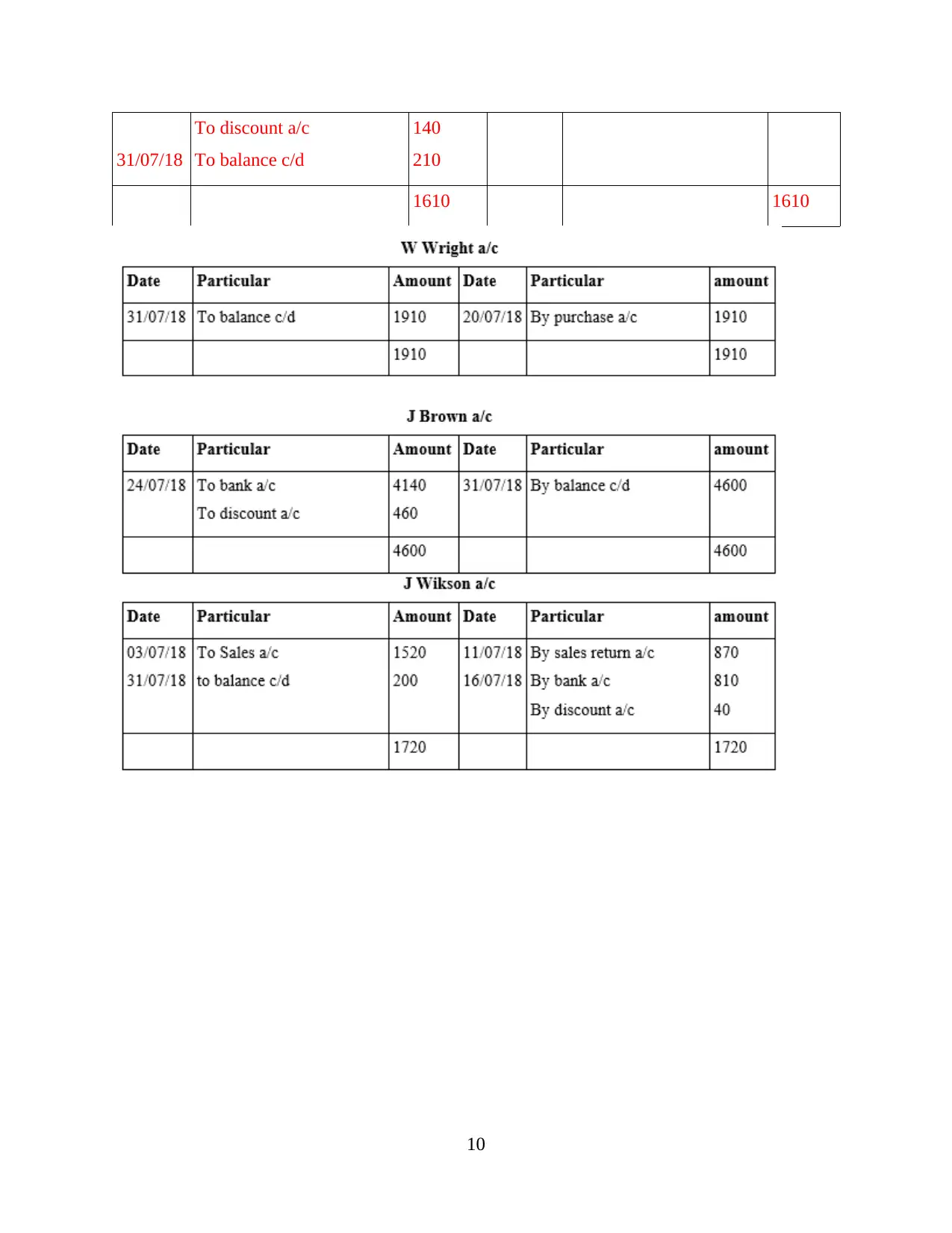
31/07/18
To discount a/c
To balance c/d
140
210
1610 1610
10
To discount a/c
To balance c/d
140
210
1610 1610
10
⊘ This is a preview!⊘
Do you want full access?
Subscribe today to unlock all pages.

Trusted by 1+ million students worldwide
1 out of 25
Related Documents
Your All-in-One AI-Powered Toolkit for Academic Success.
+13062052269
info@desklib.com
Available 24*7 on WhatsApp / Email
![[object Object]](/_next/static/media/star-bottom.7253800d.svg)
Unlock your academic potential
Copyright © 2020–2025 A2Z Services. All Rights Reserved. Developed and managed by ZUCOL.





